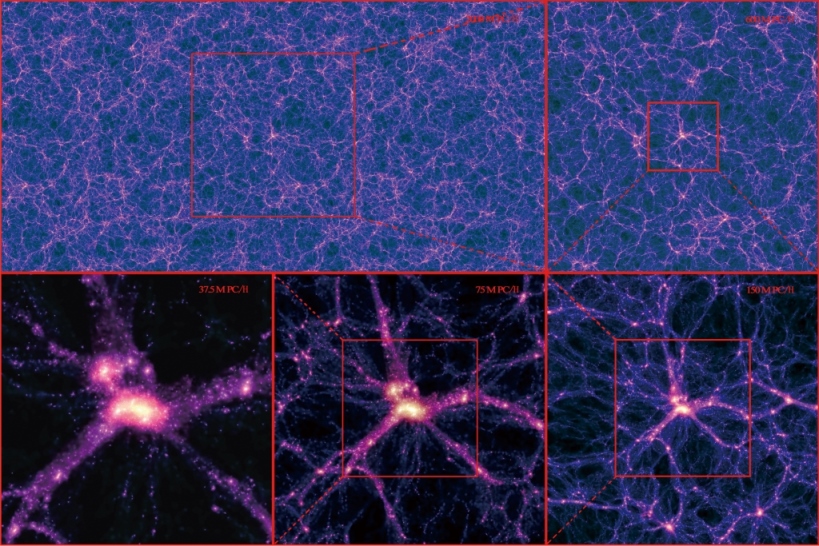Key Laboratory of Computational Astrophysics, Chinese Academy of Sciences
The Key Laboratory for Computational Astrophysics mainly studies some of the most of fundamental questions in science: What were the first objects in the Universe? How is matter in the Universe distributed? What is the nature of dark matter? How do galaxies form and evolve? High performance supercomputers are essential for these studies, just like telescopes for astronomical observers.
Focusing on understanding “Cosmic structure formation and evolution”, the studies of KLCA include but not limited to:
1)The distribution and property of dark matter
2)Dark energy and modified gravity
3)Cosmic structure formation and neutral hydrogen distribution in the early Universe
4)Galaxy formation and the Milky Way
5)Galactic dynamics
Scientific highlights:
1) The Phoenix Project
The Phoenix Project is a set of Lamda cold dark matter (CDM) simulations of the dark matter component of nine rich galaxy clusters, led by Liang Gao, and in cooperation with international cosmologists from China, German, UK, and Canada.
Each cluster is simulated at least at two different numerical resolutions. For eight of them, the highest resolution corresponds to ~130 million particles within the virial radius, while for one this number is over one billion. The structure and substructure of these systems are studied and contrasted with six galaxy-sized dark matter haloes from the Aquarius Project, simulated at comparable resolution. This comparison highlights the approximate mass invariance of CDM halo structure and substructure. Little difference is found in the spherically averaged mass, pseudo-phase-space density and velocity anisotropy profiles of Aquarius and Phoenix haloes. When scaled to the virial properties of the host halo, the abundance and radial distribution of subhaloes are also very similar, despite the fact that Aquarius and Phoenix haloes differ by roughly three decades in virial mass. The most notable difference is that cluster haloes have been assembled more recently and are thus significantly less relaxed than galaxy haloes, which leads to decreased regularity, increased halo-to-halo scatter and sizable deviations from the mean trends. This accentuates the effects of the strong asphericity of individual clusters on surface density profiles, which may vary by up to a factor of 3 at a given radius, depending on projection. The high apparent concentration reported for some strong-lensing clusters might very well reflect these effects. A more recent assembly also explains why substructure in some Phoenix haloes is slightly more abundant than in Aquarius, especially in the inner regions. Resolved subhaloes nevertheless contribute only 11 ± 3 per cent of the virial mass in Phoenix clusters. Together, the Phoenix and Aquarius simulation series provide a detailed and comprehensive prediction of the CDM distribution in galaxies and clusters when the effects of baryons can be neglected (Gao et al. 2012).

Fig 1. Dark matter distribution of one cluster in Phoenix Project.
2) PanGu Simulation
The Pangu simulation (PS-I) is a large-volume, high- resolution simulation carried out in the Supercomputing Center of CNIC, CAS, under the scheme of the Computational Cosmology Consortium of China (dubbed C4; participating institutions are NAOC, PMO, SHAO, and CNIC). The simulation contains dark matter only and uses N = 30723 particles to follow the distribution and evolution of dark matter within a periodic box with L = 1000 h^{?1} Mpc on a side.

Fig 2. Mass and energy distribution in the Pangu simulation.
Analysis of the Pangu N-body simulation validates that the bulk flow of halos follows a Maxwellian distribution with variance that is consistent with the prediction of the linear theory of structure formation. Bulk flow is only weakly correlated with the dipole of the internal mass distribution. The alignment angle between the mass dipole and the bulk flow has a broad distribution peaked at ~30?–50?, and the bulk flow shows little dependence on the mass of the halos used in the estimation. In a simulation of box size 1 h^{?1} Gpc, for a cell of radius 100 h^{?1} Mpc the maximal bulk velocity is >500 km s^{?1} ; dipoles of the environmental mass outside the cell are not tightly aligned with the bulk flow, but are rather located randomly around it with separation angles ~20?–40?. In the fastest cell there is a slightly smaller number of low-mass halos; however, halos inside are clustered more strongly at scales ??20 h?1 Mpc, which might be a significant feature since the correlation between bulk flow and halo clustering actually increases in significance beyond such scales.

Fig 3. Bulk Flow and Mass dipole from Pangu Simulation